Elderly mobility and independence

As we get older, it can become more and more difficult to get around. Even the simplest of tasks – popping to the shops, getting up and down stairs and so on – can become much more challenging with stiff and painful joints.
But there’s no reason why you should have to say goodbye to your independence altogether. Medical and technological advances are already making major improvements to the lives of those with mobility troubles, and the right kind of care can play a key role in building preventative measures into your routine – as well as supporting those day-to-day activities that might otherwise be off-limits.
In this guide, we’ll take a look at the joints that are most vulnerable in later life, and the sorts of mobility issues you might expect to arise. We’ll also explore the importance of diet and exercise in sustaining mobility in the long term, and how you can make a difference to your lifestyle right away.
Knees and hips
As the two biggest joints in the human body, knees and hips have had to bear the brunt of a lifetime of physical activity. It’s no surprise, then, that they’re some of the most common complaints among the elderly.
Why do we get knee and hip pain?
The hips are a ball and socket joint, which means they can rotate in multiple different directions. The knees are a hinge joint, and can only move back and forth.
Both rely on muscle, ligaments or cartilage to move smoothly and painlessly. Joint pain is a symptom of the damage done to these components, through years of general wear or by injury, inactivity or excessive exercise. After all, knees take the pressure of 1.5 times the weight of your body with regular walking on even ground, which almost doubles when ascending and descending stairs.
This can manifest itself in multiple different ways, including an inflammation of the sac of skin over the joint (known as bursitis), or eroded and swollen cartilage (arthritis). The good news is there are some measures they can take to ease their pain and speed up the healing process.
How to manage knee and hip pain
For those with severe pain, joint replacements and other medical options have dramatically improved mobility. But prevention is always preferable to cure, and there are a number of things you can do to care for your joints.
Regular exercise
Contrary to the belief that rest is the best medicine for sore joints, the right kind and amount of exercise can actually prove fundamental for easing soreness or stiffness. There are plenty of exercises and tips to stay healthy out there and it’s worth looking into.
It doesn’t matter if you haven’t had a particularly active lifestyle up to now, or if you’re already experiencing joint pain. It’s never too late to start. The key is simply not to overdo it, and to look into low impact exercise so as not to cause more damage to the joints.
Water aerobics and swimming are perfect examples. The natural resistance of water can allow for more movement than on dry land, without putting unnecessary pressure on the joints themselves. And, as a bonus, the warmth of the pool may help soothe any aches and pains.
But if dry land is more your cup of tea, yoga and Tai Chi are proven to improve flexibility in joints, as well as one’s overall balance. This is particularly important as it’ll serve to limit the risk of future falls and accidents when you’re up and about.
Many local gyms and recreation centres offer classes specifically designed for older people, but if not, it might still be worth enquiring if they can cater for your ability in their regular classes.
The most important thing is that you listen to your body. If you feel too much tightness in your muscles or start to feel unwell, it’s time to stop. Heat can be beneficial before exercise because it allows for increased muscle flexibility, while ice is best applied after a workout, to prevent inflammation.
The NHS has a range of exercises online, including –
- Exercises for osteoarthritis of the knee
- Exercises for knee problems
- Exercises for osteoarthritis of the hip
- Exercises for hip problems
Before starting any new exercises always consult with your GP.
If you’d prefer not to take part in organised classes to stay fit and healthy, you may find simply waking to the shops or up and down stairs can make all the difference. Whatever it is you choose to do, aim to be active for at least half an hour a day, five days a week. This will help you maintain a healthy weight (which can put extra pressure on joints), as well as keep muscles and bones strong.
Consult a medical professional on how best to do build up slowly, rather than pushing the body into too much, too quickly. The objective of physical therapy is also to increase both the range of motion in the joint, and the muscle which gives it the joint the quality of support it requires.
Exercise is just one part of a healthy lifestyle. Diet and hydration are just as essential – not only for the best results within the body, but to make training more efficient.
No matter how much you look after your own body to reduce the risk of falls and broken bones, accidents may still occur. To cover all ground, look into home safety for some great tips on how to make your home safer. Making bathrooms safe, will be a high priority as this is where a lot of slips can occur.
If you live in a house with more than one floor, look into how to make stairs safer too. If implementing specialist modifications in your home is not your forte, invest in the help of a Home Improvement Agency for any alterations or adaptations that can make your day to day life easier.
Diet
It goes without saying that a balanced and wholesome diet is essential for overall health – as well as reducing the risk of high cholesterol, and protecting the joints.
But the more you weigh, the more your bones and joints are put to work. And that’s just the start: there are lots of nutrients your bones and joints need for their repair and development.
Supplements and vitamins for these nutrients are readily available in pill form. However, you may already be taking a number of medications and not want to add more pills to their rota. Plus, it’s important to consider, along with your doctor whether you really need a supplement, and whether you can make any changes to what you eat first. Vitamin supplements can be expensive, and our kidneys often flush out anything the body doesn’t need.
- Calcium is the mineral in bone which causes its rigidity and hardness. Sources include dairy products, soya milk, tofu, sardines, salmon, figs, beans, broccoli, tinned tomatoes, dried apricots, oranges, almonds and brazil nuts.
- Vitamin D assists the body with calcium absorption. It can be found in fatty fish – tuna, salmon and mackerel – eggs, portobello mushrooms, beef liver, cod liver oil and cheese
- Vitamin K facilitates the production of a protein necessary for the making of bone. Good sources include Brussels sprouts, kale, spinach, cabbage, spring onions and prunes
- Protein is good for muscles, and can be found in meats, fish, nuts, beans, chickpeas, peas, soybeans and lentils.
If you’re taking Warfarin (a widely prescribed anticoagulant), be aware that the consumption of too much vitamin K can make the drug less effective in preventing blood clots. If in doubt, always consult a doctor.
Anti-inflammatory foods can help with conditions where the tissue around the joints becomes inflamed, such as arthritis and bursitis. Some good examples include:
- Potatoes and sweet potatoes
- Coconut milk
- Salmon
- Kale and spinach
- Nuts
Above all, a healthy diet is all about eating a rich variety of foods on a frequent basis. If the body isn’t getting enough food, it will store fat to keep from starving and will cause weight loss. It’s not good for us to dramatically cut down on food intake. This is more common than you’d think when someone lives alone or has difficulty preparing meals or shopping for themselves.
The RICE strategy
According to a report by AgeUK, an older person who has a fall has a 50 percent chance of suffering from some degree of mobility problem.
If you’ve had a fall it’s vital to seek medical attention. While waiting for medical attention you may wish to apply the RICE strategy, and it goes as follows –
- Rest: Try to keep from aggravating the injury further by giving it some time to heal. Keep the injured area still and comfortable.
- Ice: This helps reduce swelling and ease the pain (though it is ineffective on deep hip injuries). Wrap ice cubes in a kitchen towel, and apply them to the injured area for 20 minutes at a time, with equal breaks in between to avoid frostbite or damaging your skin.
- Compression: This works alongside icing to reduce swelling. Wrap up the injury with a bandage tight enough to provide support, but not so tight you reduce blood flow to the area.
- Elevation: This will prevent blood from gathering and causing further pain. Elevate the injured area by propping the knee or ankle up on pillows, if possible, above the level of the heart.
Mobility aids
Your doctor might recommend mobility aids to improve daily living, such as a cane or a walking frame to take some of the weight off your knees and hips.
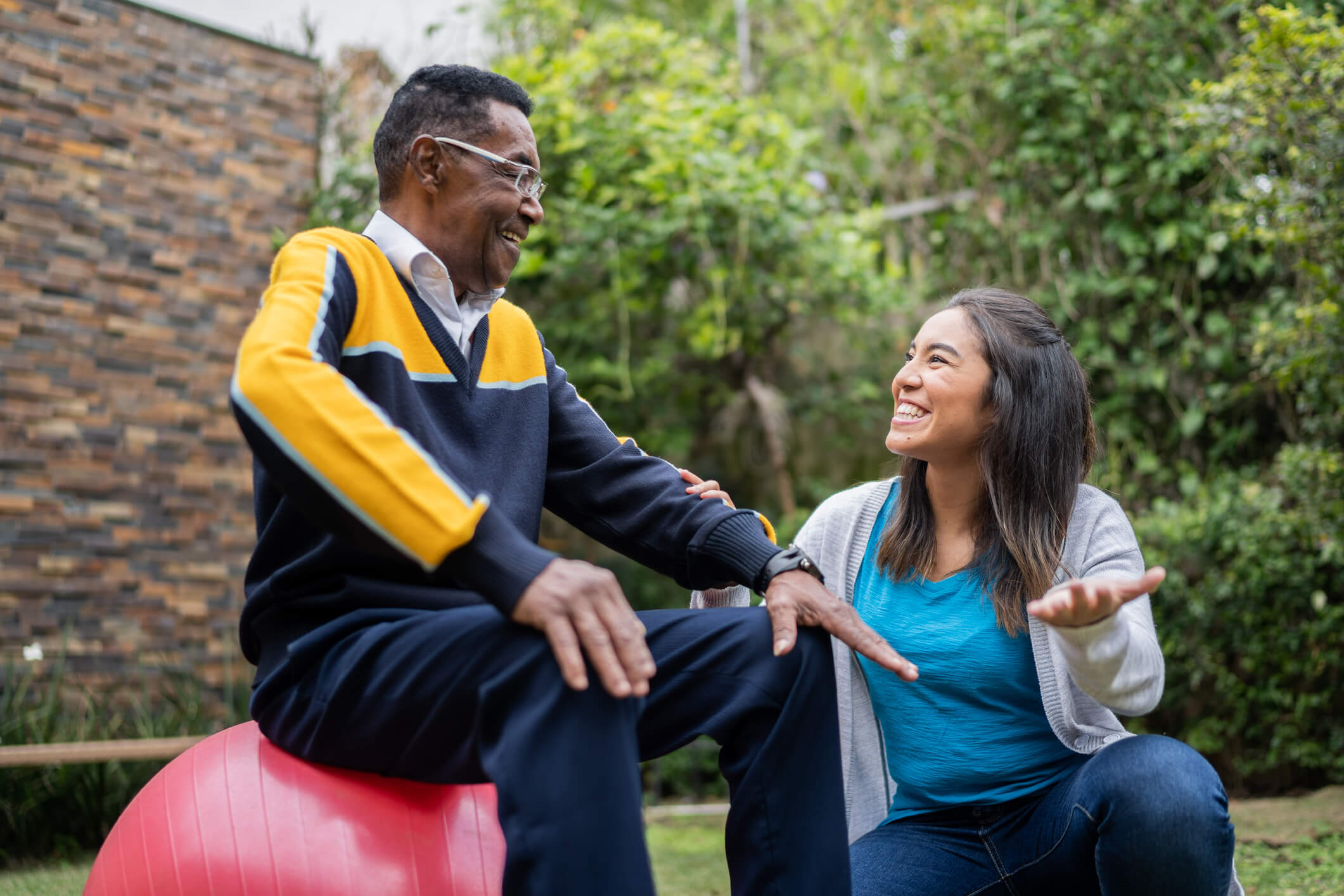
Feet and ankles
After a lifetime of wear and tear – not to mention squeezing into ill-fitting shoes – your loved one’s feet may not be in the best condition.
Foot pain can make getting out and about far more difficult, and it can increase the likelihood of an accident. So let’s take a look at the most common foot problems, and how best to manage them.
Common foot problems
There are many different kinds of problems which can affect the foot, but there are a few key ones to look out for.
Achilles tendinitis/tendinosis
The achilles tendon is located on the back of the heel and can be painful if it becomes damaged or inflamed. This occurs when it is overworked by high-impact exercise, under exertion from too much bodyweight and insufficiently supported from uncomfortable shoes.
When the tendon becomes inflamed, it is known as achilles tendinitis. When it starts to degenerate, it’s known as Achilles tendinosis. Both can be treated with the RICE strategy. Some people find using an elastic bandage or soft brace can offer some support too, however the NHS advises removing this before going to bed.
Bunions
Bunions occur when the alignment of the bone in the big toe is altered, turning inwards and squashing the toes together. They look like a lump at the base of the big toe, and are usually located at the side of the foot.
Given that bunions are often caused by pointy-toed shoes, they are found to more commonly affect women than men. The NHS recommends wearing amply spaced, comfortable shoes, or cushioning inserts. Applying ice to the area can help, too.
Hammertoes
So called due to its resemblance to a hammer, a hammertoe bends and curls due to the contraction of tendons and ligaments. This disfigurement can cause rubbing in shoes and against other toes, leading to corns, calluses, bursitis and more.
Initially, the toe will be able to be flattened back down with pressure, but over time it will harden and potentially become even more painful. Some people find soaking their feet in warm water and then doing stretched can help, as can choosing comfortable footwear.
Foot and ankle osteoarthritis
Osteoarthritis causes joints to become painful and stiff. It’s the most common type of arthritis in the UK.
Luckily, there are ways of easing arthritis pain in the elderly. There are a number of simple exercises you may wish to try, including –
- Picking up a towel with scrunched toes
- Rolling the arch of your foot on a tennis ball.
- Sitting down and moving your ankles around in circles both anti-clockwise and clockwise
- Raising your heels while sitting upright, keeping your toes on the floor.
Always consult a GP before trying new exercises, especially if you’re living with an condition like arthritis. .
In looking after the overall health of the feet, it’s important to:
- Maintain a healthy diet, to limit the strain on joints and the risk of contracting medical conditions
- Wear shoes that fit properly, to prevent cramping or rubbing
- Keep your feet clean and dry to avoid bacterial growth, and nails cut and maintained to prevent inward growth
- Stretch and massage feet, to keep an active blood-flow
Calluses and corns
Usually found on the underside of the foot, calluses are areas of thick, hard skin caused by friction with the ground or the soles of shoes. Corns are similar, but smaller and usually on the toes. They aren’t necessarily unusual, but in more extreme cases they can limit mobility and cause pain.
They’ll often get better by themselves with comfortable shoes, though you can help them along by soaking them in warm water, removing dead skin with a pumice stone and applying moisturiser to the area. Make sure you’re careful if you have diabetes or other circulatory issues, as overzealous treatment can cause infection. In these cases, consult your GP or seek guidance from a foot care specialist, such as a chiropodist.
Plantar Fasciitis
The plantar fascia is the band of tissue connecting the ball of the foot to the heel, and is vulnerable to irritation and inflammation. This is known as plantar fasciitis, and can cause severe heel pain.
To manage plantar fasciitis, you may find relief from massaging the underside of the foot with a massage ball (a golf or tennis ball can also be used), and do some very gentle toe-point stretches. The NHS also suggest using an ice pack (or bag of frozen peas) in a towel for up to 20 minutes every 2 to 3 hours.
Gout
A form of arthritis, gout is caused by uric acid crystals forming in/around the joint, typically at the base of the big toe. It can be identified by a shiny red swollen joint.
A buildup of uric acid in the bloodstream can be caused by eating certain foods in excess, such as red meat, seafood and offal. Those who are overweight, living with diabetes or have high blood pressure are at a greater risk of contracting gout. Uric levels in women increase after menopause, putting them at a higher risk of gout than men.
Identifying and avoiding any common triggers is important with gout and will allow you to make the right lifestype changes to minimise flare ups. Gout should be managed under the supervision of your GP, who’ll advise on the right medications to relieve symptoms during an attack.
Damage caused by diabetes
Diabetes can cause nerve damage that impedes the body’s ability to sense pain, and impair blood vessels and lead to poor circulation.
This has two outcomes: nerve damage puts the individual at risk of unnoticed harm to the foot, and poor circulation means the body won’t be equipped to fight infection. In the most extreme circumstances, the infection may reach the bone and the limb may need to be amputated. This is why foot care is so important for diabetes patients.
This means you’ll likely need to follow some simple rules, including wearing clean socks every day and comfortable shoes with plenty of support, and avoiding going barefoot to reduce the risk of scratches or sores. If you do happen to cut yourself the NHS advise you seek the support of a medical professional immediately.
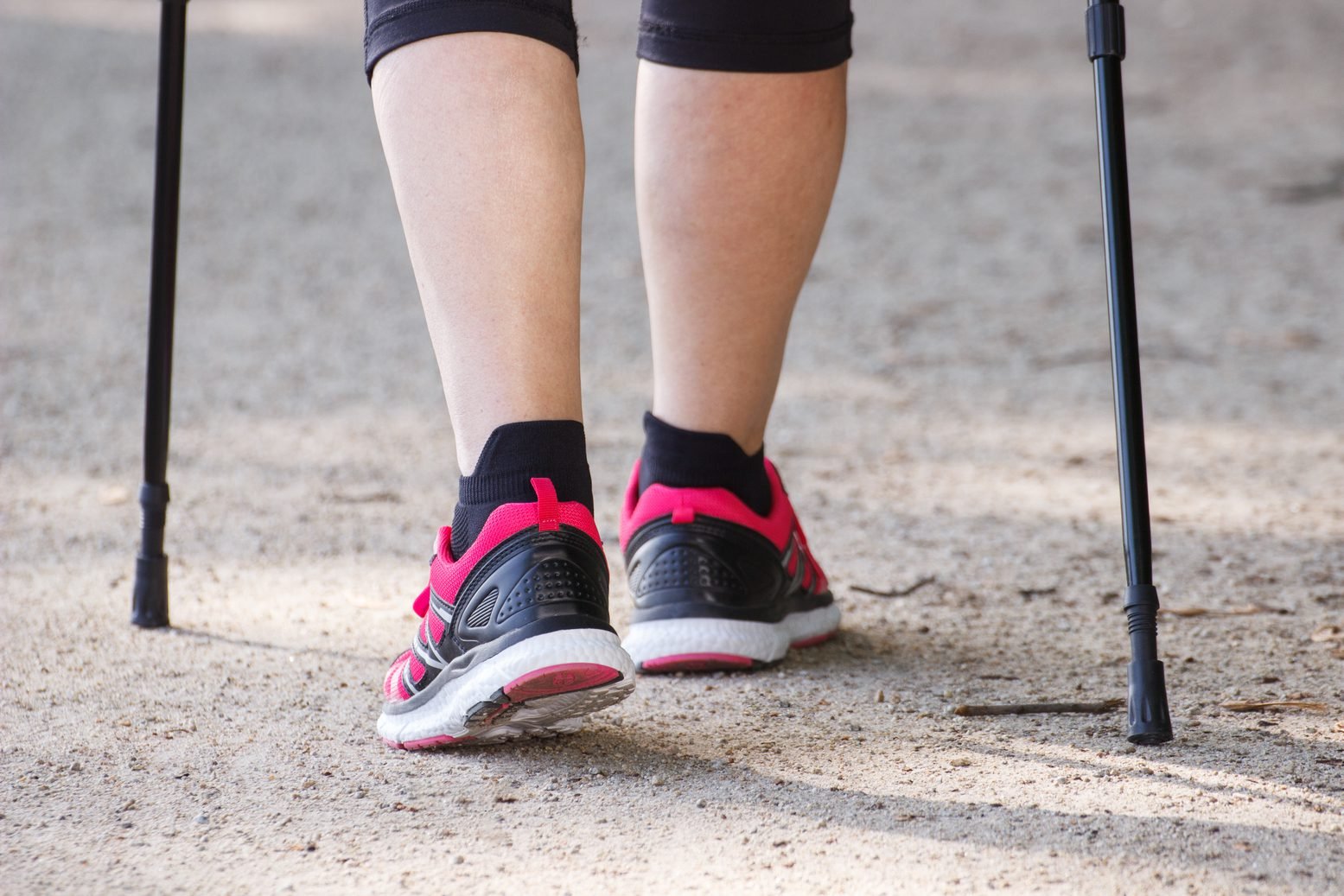
Back and Posture
The spine is formed by vertebrae, muscles, ligaments, discs and nerves, all of which work together to allow us to move, twist and bend. Over time, any and all of these components can start to wear down, and this is how back pain sets in.
Once it does, the pain can quickly escalate and become debilitating. This isn’t just bad news for mobility, it also has a significant impact on your independence. And when those movements we do so instinctively and on such a regular basis become painful, quality of life can decline.
Posture
Many people think good posture is simply a matter of keeping your back straight, but this can be a misleading way of thinking.
After all, the spine isn’t actually straight: it’s divided into three sections, each of which is curved to support the weight of the body evenly. Instead, it’s better to think of it as keeping the body open, with shoulders back, chin up and chest forward. This naturally has the effect of stretching out the spine and the lines of fascia that keep the body moving in a cohesive and efficient way.
There are some simple ways to improve posture in day-to-day life, again this is general NHS advice, if you have back problems, always seek personalised advice from a doctor who knows your medical history –
- Sit upright. Keep your feet flat on the floor (or on a stool or pillow if they don’t reach), with knees raised slightly higher than the hips and bent at a 90-degree angle
- Have breaks from your armchair: get up, walk around and stretch your legs while watching television
- Take a load off your feet: keep one foot elevated one a small stool while doing tasks like ironing that require standing for ongoing periods
- Get a good night’s rest. Sleep on a mattress and pillows that adequately support the head and spine
In fact, sleeping badly can be a key causes of back pain. Pillows which are too thin or too thick might not correctly support the neck, and a soft mattress might cause the spine to distort. Together, these are likely to increase the pressure on certain parts of the back. Even with a better quality of mattress, you may still need to adapt the way you sleep – for example, on your side with knees bent up towards the chest – to keep yourself comfortable.
Including some simple exercises in your daily routine may help keep your back as mobile as possible. Squats, in particular, may provide some people with added stability in the feet, legs, hips and lower back.
- Point your knees, feet and head straight ahead of you.
- Distribute your weight evenly across both feet and the hips, without leaning on either side too heavily.
- Keep your shoulders back, your chest out and your chin parallel with the floor.
- Squat on bended knees as far as is comfortable, keeping your abdominal muscles in
- Push upwards – through the glutes rather than the knees – to return to the standing position.
If you feel confident to do these exercises alone and that it is safe to do so, you may find it useful to use a mirror to see how your posture’s coming along.
Back
It’s worth watching out for a few specific conditions when taking care of your back.
Slipped or ruptured discs can occur when the spongy centre of the disc starts to bulge, tearing the outer casing and pressing into the nerves. Once it is ruptured, it can cause inflammation, pain and, in some cases, sciatica – a shooting pain down the length of the leg and foot.
An intervertebral disc rests between each vertebra in the spine. They act as a ligament to hold the vertebrae together, as well as to allow for movement and absorb shock. When the spine is subjected to excessive weight, bad posture and sharp movements – or just as a result of a lifetime of use – these discs can start to deteriorate, and their alignment start to shift. This is known as a disc abnormality.
This kind of problem can take up to six months to heal. The NHS suggests that in the meantime, people use medication for the pain, and do gentle exercises recommended by a qualified physiotherapist or GP.
Spinal stenosis is a narrowing of the spinal canal, which can restrict the spinal cord, put pressure on the nerves and cause numbness. It is most common in older people.
Gentle exercise or physical therapy might not directly heal the complaint, but it will aid strength and flexibility, especially while treating the issue.
Compression fractures occur when the vertebrae collapse under the pressure bearing down on the bone. They are particularly likely to occur as a result of osteoporosis, a condition that weakens the bone. For some, they cause sharp pain and spasms. But for others, they may only affect posture.
Compression fractures can heal naturally, and usually taking up to six months. In the short term, the discomfort can be intense, and you may need a back brace, bed rest or painkillers to provide some relief. The pain should, however, start to lift within a few days or weeks.
Hyperkyphosis can cause the back to hunch in an exaggerated way. This can compress the chest cavity, cause breathing problems and increase the risk of a fracture.
Treatment of hyperkyphosis can include specialised back braces, therapeutic tape to assist with posture, pain management in the form of ice or heat and training or advice from a physical therapist.
There’s no single cause of hyperkyphosis, and there’s no single way to prevent it. Improving posture and flexibility can help, making yoga and Tai Chi an increasingly popular pastime for people of a certain age. Arthritis Research UK also provides a number of exercises your loved one can do at home to strengthen your loved one’s back muscles and abdomen.
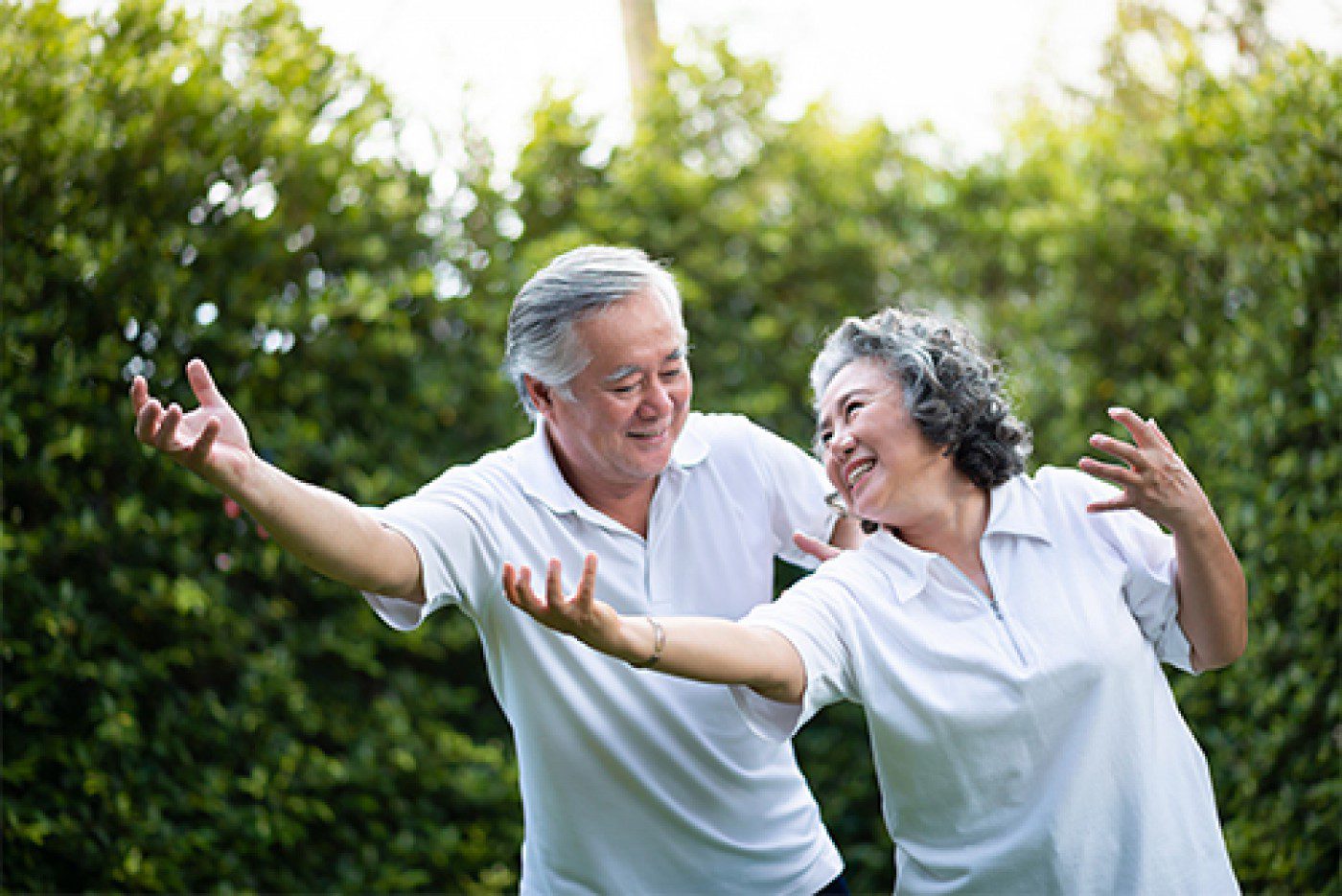
Living well with limited mobility
There are heaps of opportunities for those in later life to live as enjoyable and fulfilling a life as they always have done. From countryside walks to world-class museums, there are all sorts of ways to exercise the body and enrich the mind. It’s just a matter of finding the right places to go – and making plans in advance to prepare for anything that may come your way.
Planning ahead
Make sure you always check that your destination of choice is accessible, and that it has the facilities your loved one needs.
You might want to know if there are any stairs to climb, and if there are any lifts available. You might need to ask if paths are well-suited to your level of mobility. And if there are longer distances involved, you might want to consider arranging a wheelchair even if you don’t tend to use one.
Before you head out, work out where the rest stops are along the way. While you may not want or need to take a breather, at least you’ll know somewhere good to grab a cup of tea or a bite to eat, stretch your legs, or use the loo. You’d also be best starting with shorter, more local activities to see how you find things, and try more ambitious outings next time.
So what sort of things might you want to do? Here are a few ideas to inspire you.
OpenBritain and The Carers Trust charity offer plenty of information and ideas for days out, as well as a list of accessible destinations and places to stay.
How Elder can help
Our mission is to make personalised live-in home care more accessible to more people.
This means we go the extra mile in everything we do. We don’t just connect you to highly qualified caregivers to provide dedicated one-to-one care – we uniquely match you to carers based on your needs and personality.
Let us know what you like and don’t like – and what you’re looking for in a carer – this may be someone to help you tackle certain daily tasks that are becoming more difficult, or simply someone to share your life and enjoy trips out with. We’ll introduce you to someone who’ll give help you live life as you always have done, and fit right into the family while they’re at it.
The self-employed carers on our platform are some of the best in the UK, chosen by our in-house team of experts. Only 10% of our applicants make the grade. Whether you need a long-term solution to ongoing conditions or just a short-term fix, get in touch.
Mobility and independence
Elder-approved carers know just how important it is for you to feel able to get up and about and maintain your independence, and they’ll make sure you’re able to do just that.
There’s no end to the support they can offer – everything from help with exercises and getting to and from appointments, to ensuring you have plenty of time for hobbies and seeing friends.
We have an expert team on hand to help you make sense of how the carers we work with can support your needs.
Get in touch on 0333 920 3648 or drop us an email at [email protected] and we’ll be more than happy to help.
This article is for informational purposes only and not to be taken as medical advice. For medical advice, always consult your GP.
Read more care guides
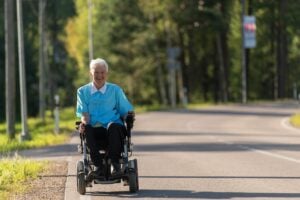
Mobility aids for the elderly to improve daily living
Mobility aids for the elderly to improve daily living As we age, our balance can often become compromised, leading to slips, trips and falls. While
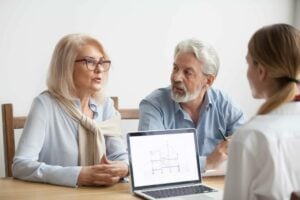
What is a home improvement agency?
What is a Home Improvement Agency? A home improvement agency, also known as an HIA, is part of a network of organisations which has the

Home adaptations for the elderly
Home adaptations for the elderly Quick links Small adaptations Larger adaptations Bathroom Bedroom Kitchen Funding for home adaptations Home improvement agencies Did you know

A guide to home safety for the elderly
A guide to home safety for the elderly As your loved one grows older, you may become more concerned about how safe they are at

Supplements and vitamins for the elderly
Supplements and vitamins for the elderly As we age, our nutritional needs change, meaning that a diet that was appropriate in our younger years may
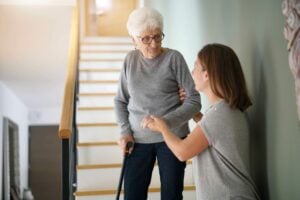
How to make stairs safe for the elderly
How to make stairs safe for the elderly If your elderly loved one is living in a house with stairs, it’s important to make sure